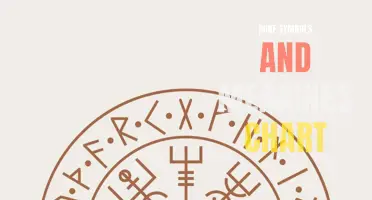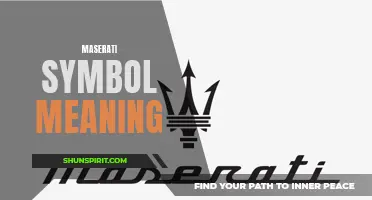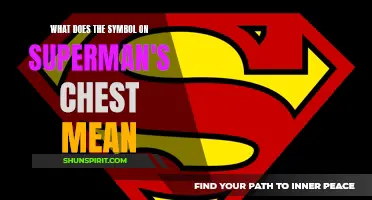
Passover, also known as Pesach, is one of the most important and widely celebrated Jewish holidays. It commemorates the liberation of the Israelites from slavery in ancient Egypt, as described in the biblical Book of Exodus. One of the unique aspects of Passover is the symbolism and meaning behind its various traditions and rituals. From the unleavened bread known as matzah to the bitter herbs representing the bitterness of slavery, each symbol carries a profound message and serves as a reminder of the Jewish people's journey from oppression to freedom. Join me as we explore the rich symbols and meanings of Passover, shedding light on the deep significance of this holiday.
What You'll Learn
- What are some of the main symbols associated with Passover and what do they represent?
- How do the four cups of wine served during the Passover Seder relate to the meaning of the holiday?
- What is the significance of the matzah (unleavened bread) that is eaten during Passover?
- Can you explain the symbolism behind the lamb bone that is typically present on the Passover Seder plate?
- Are there any other symbols or objects that are commonly used during Passover and what do they symbolize?

What are some of the main symbols associated with Passover and what do they represent?
Passover is a significant Jewish holiday that commemorates the liberation of the Israelites from slavery in ancient Egypt. This holiday is celebrated with a variety of customs and rituals, many of which involve symbolic elements. Here are some of the main symbols associated with Passover and what they represent:
- Matzah: Matzah is unleavened bread, which is made without yeast. It is one of the most important symbols of Passover, representing the haste in which the Israelites had to leave Egypt. According to the biblical narrative, the Israelites did not have enough time to let their bread rise before they fled, so they had to eat unleavened bread instead. Matzah is eaten throughout the holiday, and it is also used during the Passover Seder.
- Maror: Maror refers to the bitter herbs that are eaten during the Passover Seder. These bitter herbs symbolize the bitterness of slavery that the Israelites experienced in Egypt. The most commonly used bitter herb is horseradish, which is traditionally eaten with matzah and charoset (a mixture of apples, nuts, wine, and spices).
- Charoset: Charoset is a sweet mixture made of apples, nuts, wine, and spices. It symbolizes the mortar that the Israelite slaves used to make bricks in Egypt. The texture and color of charoset resemble the mortar, and it provides a sweet contrast to the bitterness of the maror. Charoset is typically eaten with matzah during the Passover Seder.
- Seder Plate: The Seder plate is a special plate used during the Passover Seder to hold the symbolic foods mentioned above. It usually has separate compartments for the matzah, maror, and charoset, as well as additional symbolism such as a roasted egg, a shank bone (or chicken bone), and parsley or lettuce. Each item on the Seder plate has its own significance and is referenced during the retelling of the Passover story.
- Cup of Elijah: During the Passover Seder, an extra cup of wine is placed on the table for the prophet Elijah. This cup is not drunk by the participants, but rather it symbolizes the hope for the future redemption of the Jewish people. According to tradition, Elijah will come to announce the arrival of the Messiah and the ultimate redemption of all humankind.
These symbols play an important role in the Passover celebration, as they help to retell the story of the Israelites' liberation and serve as reminders of the hardships they endured. By incorporating these symbols into the Passover rituals, Jewish people around the world not only remember their history but also celebrate their freedom and hope for a better future.
The Rich Symbolism and Fascinating Meanings Behind Mesopotamian Symbols
You may want to see also

How do the four cups of wine served during the Passover Seder relate to the meaning of the holiday?
The Passover Seder is a significant event in the Jewish faith, commemorating the liberation of the Israelites from slavery in ancient Egypt. With a strong emphasis on storytelling and symbolic rituals, the Seder is a time for reflection, gratitude, and remembrance. One of the key components of the Seder is the four cups of wine that are served throughout the evening. These four cups hold great significance and play a vital role in connecting the meaning of the holiday with the rituals of the Seder.
Each of the four cups of wine represents a different aspect of the Exodus story and carries its own symbolic meaning. The first cup, known as the Kiddush, is a symbol of sanctification. It represents the beginning of the Seder and sets the tone for the rest of the evening. As the cup is raised, a blessing is recited, signifying the holiness of the occasion and the importance of retelling the story of the Exodus.
The second cup, known as the Maggid, is the cup of plagues. As the name suggests, this cup represents the ten plagues that God inflicted upon the Egyptians as a means of persuading Pharaoh to release the Israelites from slavery. Each participant at the Seder dips a finger into their cup and removes a drop of wine, representing the diminishing joy caused by the suffering of the Egyptians.
The third cup, known as the Birkat Hamazon, or the cup of redemption, symbolizes the moment of liberation. It is during this part of the Seder that the Haggadah, the book that guides the evening's rituals and storytelling, is read. This cup serves as a reminder of the Israelites' ultimate redemption from slavery and the gratitude felt for God's intervention.
Finally, the fourth cup, known as the Hallel, symbolizes praise and thanksgiving. It is at this point in the Seder that psalms of praise and thanksgiving are sung, expressing gratitude for the miracles and blessings experienced during the Exodus. This cup is a reminder of the joy and freedom that the Israelites experienced once they were no longer under the yoke of slavery.
The four cups of wine served during the Passover Seder represent different stages of the Exodus story and carry deep symbolic meaning. They serve as a visual reminder of the hardships endured by the Israelites, the divine intervention that brought about their liberation, and the gratitude and praise felt for their newfound freedom. As participants partake in each cup, they connect with the meaning of the holiday, fostering a sense of unity, faith, and appreciation for the past.
The Symbolic Meaning of Wheat: Exploring its Significance Across Cultures and Time
You may want to see also

What is the significance of the matzah (unleavened bread) that is eaten during Passover?
Passover is one of the most important holidays in the Jewish religion, commemorating the liberation of the Israelites from slavery in ancient Egypt. During this eight-day festival, there are several significant rituals and traditions that must be followed, including the consumption of matzah, also known as unleavened bread. Matzah holds great symbolic and historical significance and represents key aspects of the Passover story.
Matzah is a flat, unleavened bread that is made without yeast or any leavening agents. This process of making unleavened bread is quite intricate and involves strict adherence to specific guidelines. According to tradition, the dough for matzah must be made and baked within 18 minutes to prevent any fermentation and rising. Any dough that exceeds this time limit is considered leavened and cannot be used during Passover.
The significance of matzah lies in its connection to the story of the Israelites' hasty departure from Egypt. According to the biblical account, the Israelites were instructed to eat unleavened bread during their exodus from Egypt. This was because they did not have enough time to allow their bread to rise before leaving. In their hurry to escape slavery, they took their dough with them and baked it into matzah, which became their staple food during their journey through the desert.
Eating matzah during Passover serves as a reminder of the humble origins and the suffering endured by the Israelites during their time in Egypt. It symbolizes their enslavement, the haste of their departure, and their reliance on God's guidance and protection. By consuming matzah, Jews today connect themselves to their ancestors and remember their liberation from bondage.
The process of making matzah also holds spiritual significance. The strict time limit of 18 minutes emphasizes the need for urgency and dedication in following God's commandments. It is a reminder of the Israelites' unwavering faith and obedience to God's instructions during their exodus. The haste in making matzah also serves as a metaphor for the haste with which the Israelites had to leave Egypt.
Furthermore, matzah represents the concept of humility and the avoidance of arrogance. The absence of leavening agents in matzah symbolizes the absence of inflated egos or false sense of self-importance. It serves as a reminder to remain humble and appreciate the blessings and freedom bestowed upon the Jewish people.
During the Passover Seder, the ceremonial meal held on the first two nights of Passover, specific rituals are performed with the matzah. The matzah is broken into three parts, symbolizing the divisions of the Jewish nation – priests, Levites, and Israelites. The middle part, known as the afikomen, is hidden and later found by children, who then ransom it for a reward. This tradition adds an element of fun and engagement for the younger participants while maintaining the symbolism of unity and redemption.
In conclusion, the significance of matzah during Passover is rooted in its connection to the historical events of the Exodus and the Israelites' journey from slavery to freedom. Matzah serves as a reminder of their hasty departure, the reliance on God's guidance, and the humility and obedience demonstrated during that time. It is a symbol of liberation, unity, and gratitude that continues to be observed by Jews worldwide during the annual celebration of Passover.
Decoding the Enigmatic Berber Symbols: Unraveling Their Deep Meanings
You may want to see also

Can you explain the symbolism behind the lamb bone that is typically present on the Passover Seder plate?
The Passover Seder plate is an integral part of the Passover celebration, a Jewish holiday that commemorates the liberation of the Israelites from slavery in Egypt. The plate is typically arranged with various symbolic foods, each with its own significance and meaning. One common item found on the Passover Seder plate is a lamb bone, which holds great symbolism in the context of the holiday.
The lamb bone represents the Paschal lamb that was sacrificed during the time of the Temple in Jerusalem. According to the Book of Exodus in the Bible, before the Israelites were liberated from Egypt, God commanded them to sacrifice a lamb and smear its blood on the doorposts of their homes. This act would serve as a sign, and the Angel of Death would "pass over" the homes of the Israelites, sparing them from the final and most devastating plague that struck the Egyptians – the death of the firstborn.
The lamb bone on the Seder plate is a reminder of the sacrifice made by the Israelites and the protection they received from God during their exodus from Egypt. It is a visual representation of both the Paschal sacrifice and the divine intervention that allowed the Israelites to escape their oppressors.
Moreover, the lamb bone also signifies the concept of redemption and freedom. Just as the Israelites were redeemed from slavery, the Passover holiday serves as a reminder of the ongoing journey towards liberation and freedom from various forms of oppression in our lives. The lamb bone serves as a powerful symbol of hope and the potential for transformation.
In addition to its symbolic significance, the presence of the lamb bone on the Seder plate also serves a practical purpose. It is a reminder of the historical and religious context of the holiday and helps to create a sense of connection to the ancient traditions of the Israelites.
During the Passover Seder, the lamb bone is not eaten. It remains on the Seder plate throughout the evening, serving as a visual reminder of the story and significance of the holiday. While the sacrifice of the Paschal lamb is no longer practiced today, the lamb bone remains an important symbol for Jews observing the Passover and serves as a reminder of the collective history and journey of the Jewish people.
In conclusion, the lamb bone on the Passover Seder plate carries deep symbolism and meaning. It represents the sacrifice made by the Israelites, the protection they received during the exodus from Egypt, and the ongoing journey towards liberation and freedom. It serves as a powerful reminder of the historical and religious context of the holiday and helps to create a sense of connection to the ancient traditions of the Jewish people.
Unlocking the Secrets of Lent: Exploring the Symbols and Meanings
You may want to see also

Are there any other symbols or objects that are commonly used during Passover and what do they symbolize?
Passover, also known as Pesach, is a Jewish holiday that commemorates the liberation of the Israelites from slavery in ancient Egypt. This important celebration is marked by various rituals, symbols, and objects, each carrying deep meaning and significance. While the Seder plate is the most prominent symbol of Passover, there are several other symbols and objects that are commonly used during this holiday.
One of the most recognizable symbols of Passover is the Matzah, a type of unleavened bread. Matzah represents the haste in which the Israelites left Egypt. According to the biblical account, they did not have enough time to wait for bread to rise, so they baked unleavened bread, which became known as Matzah. During Passover, it is customary to eat Matzah to remember the Israelites' hurried departure from Egypt.
Another important symbol during Passover is Maror, bitter herbs, which represent the bitterness and suffering endured by the Israelites while enslaved in Egypt. The Maror is usually horseradish or another bitter herb, and it is eaten to remind Jews of the hardships their ancestors faced and to encourage empathy and compassion for those who are suffering today.
Charoset is another symbolic food item that is commonly found on the Seder plate. This sweet mixture, resembling mortar, is made from a combination of apples, nuts, spices, and wine. Charoset symbolizes the mortar used by the Israelites while building structures for their Egyptian captors. Its sweet taste serves as a reminder that even in times of hardship, there can be moments of joy and sweetness.
The shank bone, or Zeroa, is another symbol used during Passover. It represents the lamb that was sacrificed and its blood spread on the doorposts of Jewish homes, saving their firstborns from the tenth plague, known as the Plague of the Firstborn. The Zeroa reminds Jews of God's protection and redemption during their liberation from slavery.
Eggs are also a common symbol on the Seder plate, usually representing new beginnings and fertility. Some interpretations connect the egg with the circular and cyclical nature of life, while others view it as a symbol of the holiday's springtime association.
Additionally, saltwater is often included on the Seder plate to represent the tears shed by the Israelites during their enslavement. It serves as a reminder of the hardships they endured and the need for empathy and compassion towards those who suffer.
These symbols and objects play a significant role in the Passover celebration, each carrying a unique meaning and reminding Jews of their history, the pain of slavery, and the joy of freedom. They serve as powerful visual reminders of the Exodus story and the importance of remembering and retelling it each year.
Decoding the Mystical Meanings of the Monas Hieroglyphica Symbol
You may want to see also
Frequently asked questions
The Seder plate is a central symbol of the Passover celebration. It holds the six traditional items that are essential to the retelling of the story of the Jewish liberation from slavery in Egypt. Each item on the Seder plate represents a different part of the Passover story and serves as a visual and tangible reminder of the Jewish people's journey to freedom.
Matzah, or unleavened bread, is a key symbol of Passover. It represents the haste in which the Jewish people left Egypt, as they did not have time to wait for their bread to rise. It is also a reminder of the hardships and uncertainties of slavery, and serves as a reminder to be grateful for freedom.
The bitter herb, usually horseradish, is a reminder of the bitterness and harshness of slavery. It symbolizes the difficult experiences and suffering that the Jewish people endured while enslaved in Egypt. By tasting the bitterness, those celebrating Passover are reminded to appreciate their freedom and to empathize with those who are still oppressed.
The cup of wine is a symbol of joy and celebration in the Passover Seder. It represents the four expressions of redemption mentioned in the Exodus story, which are freedom, deliverance, redemption, and taking the Jewish people as God's chosen nation. It is also a symbol of thanksgiving and gratitude for the liberation from slavery.







